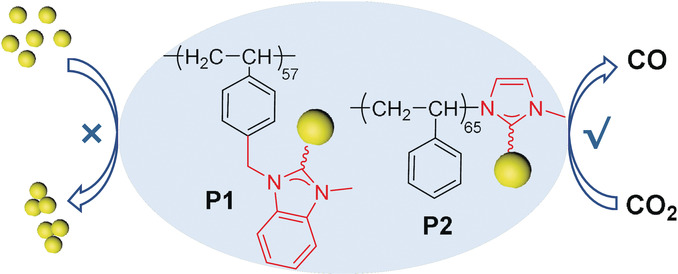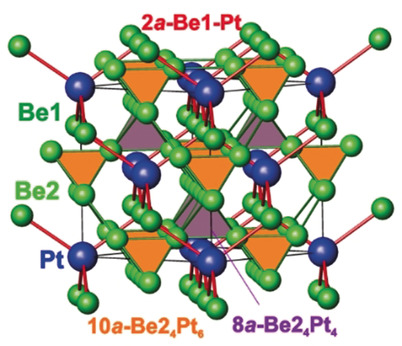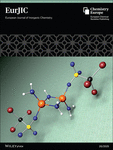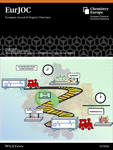Journal list menu
Export Citations
Download PDFs
Cover Pictures
Cover Picture: The Three-Dimensional Dendrite-Free Zinc Anode on a Copper Mesh with a Zinc-Oriented Polyacrylamide Electrolyte Additive (Angew. Chem. Int. Ed. 44/2019)
- Page: 15555
- First Published: 23 September 2019

A combination of a Cu–Zn solid solution interface on copper mesh with good zinc affinity and a polyacrylamide electrolyte additive (PAM) is developed to modify the zinc anode. As shown by H. Wang et al. in their Communication on page 15841 ff., the Cu–Zn solid solution formed in the initial process can regulate zinc nucleation and PAM can suppress the growth of zinc dendrites in the subsequent cycles. The prepared zinc anodes show a dendrite-free behavior.
Inside Cover: Enantiospecific Desorption Triggered by Circularly Polarized Light (Angew. Chem. Int. Ed. 44/2019)
- Page: 15556
- First Published: 15 October 2019
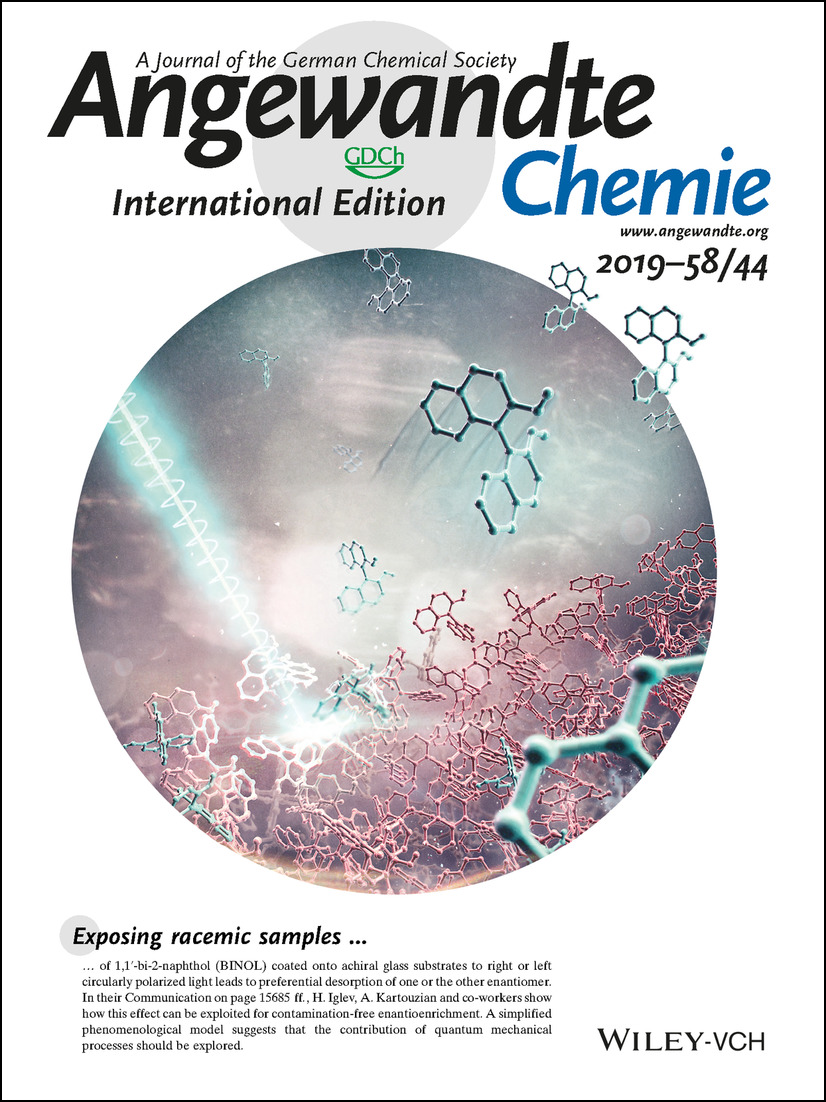
Exposing racemic samples of 1,1′-bi-2-naphthol (BINOL) coated onto achiral glass substrates to right or left circularly polarized light leads to preferential desorption of one or the other enantiomer. In their Communication on page 15685 ff., H. Iglev, A. Kartouzian and co-workers show how this effect can be exploited for contamination-free enantioenrichment. A simplified phenomenological model suggests that the contribution of quantum mechanical processes should be explored.
Inside Back Cover: Exploiting Coordination Isomerism for Controlled Self-Assembly (Angew. Chem. Int. Ed. 44/2019)
- Page: 15937
- First Published: 11 October 2019
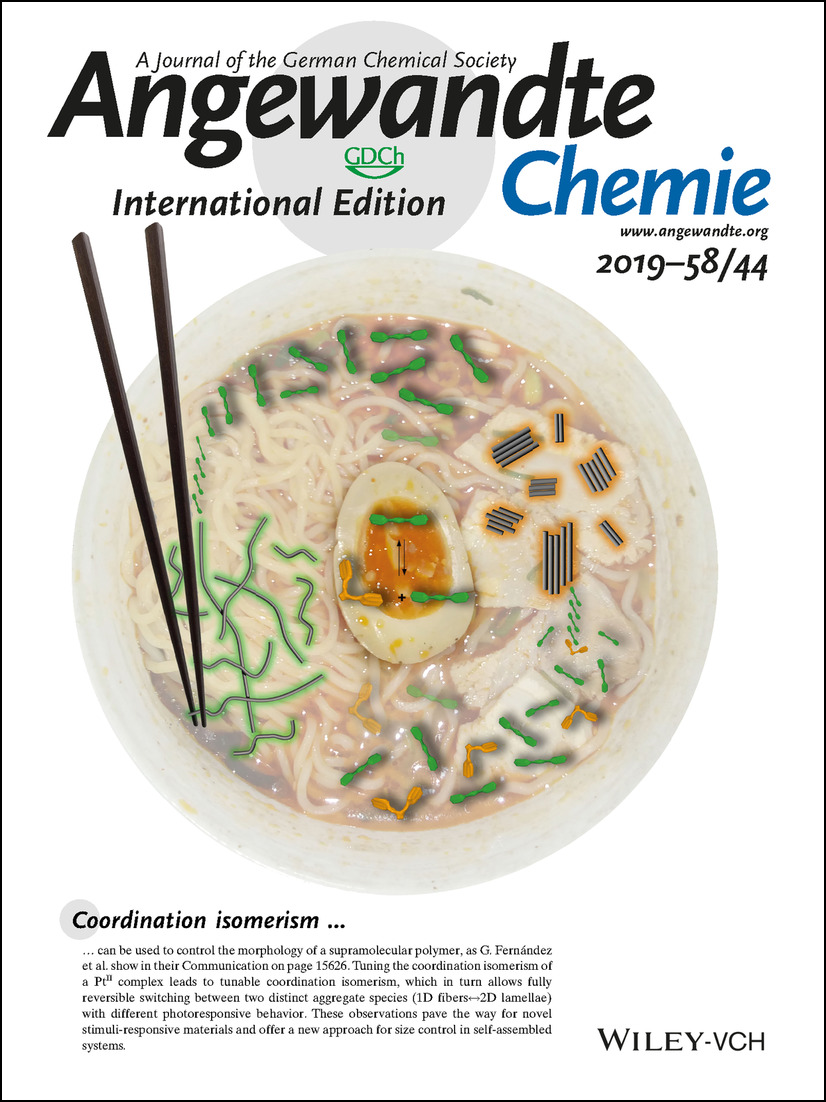
Coordination isomerism can be used to control the morphology of a supramolecular polymer, as G. Fernández et al. show in their Communication on page 15626. Tuning the coordination isomerism of a PtII complex leads to tunable coordination isomerism, which in turn allows fully reversible switching between two distinct aggregate species (1D fibers↔2D lamellae) with different photoresponsive behavior. These observations pave the way for novel stimuli-responsive materials and offer a new approach for size control in self-assembled systems.
Back Cover: [UF6]2−: A Molecular Hexafluorido Actinide(IV) Complex with Compensating Spin and Orbital Magnetic Moments (Angew. Chem. Int. Ed. 44/2019)
- Page: 15938
- First Published: 18 September 2019
![Back Cover: [UF6]2−: A Molecular Hexafluorido Actinide(IV) Complex with Compensating Spin and Orbital Magnetic Moments (Angew. Chem. Int. Ed. 44/2019) Volume 58 Issue 44, 2019](/cms/asset/22a4b2c8-1213-4e74-b347-25e2247be955/anie201911582-toc-0001-m.jpg)
Insights into the electronic properties of actinide ions can be obtained by using X-ray magnetic circular dichroism spectroscopy. In their Communication on page 15650 ff., K. S. Pedersen, R. Clérac, and co-workers present the first structurally characterized hexafluorido complex of a tetravalent actinide ion, [UF6]2–. Its non-magnetic ground state results from an almost perfect cancellation of spin and orbital magnetic moments, which are virtually identical in magnitude but opposite in sign.
Frontispiece
Frontispiece: Molecular Semiconductor Surfactants with Fullerenol Heads and Colored Tails for Carbon Dioxide Photoconversion
- First Published: 21 October 2019
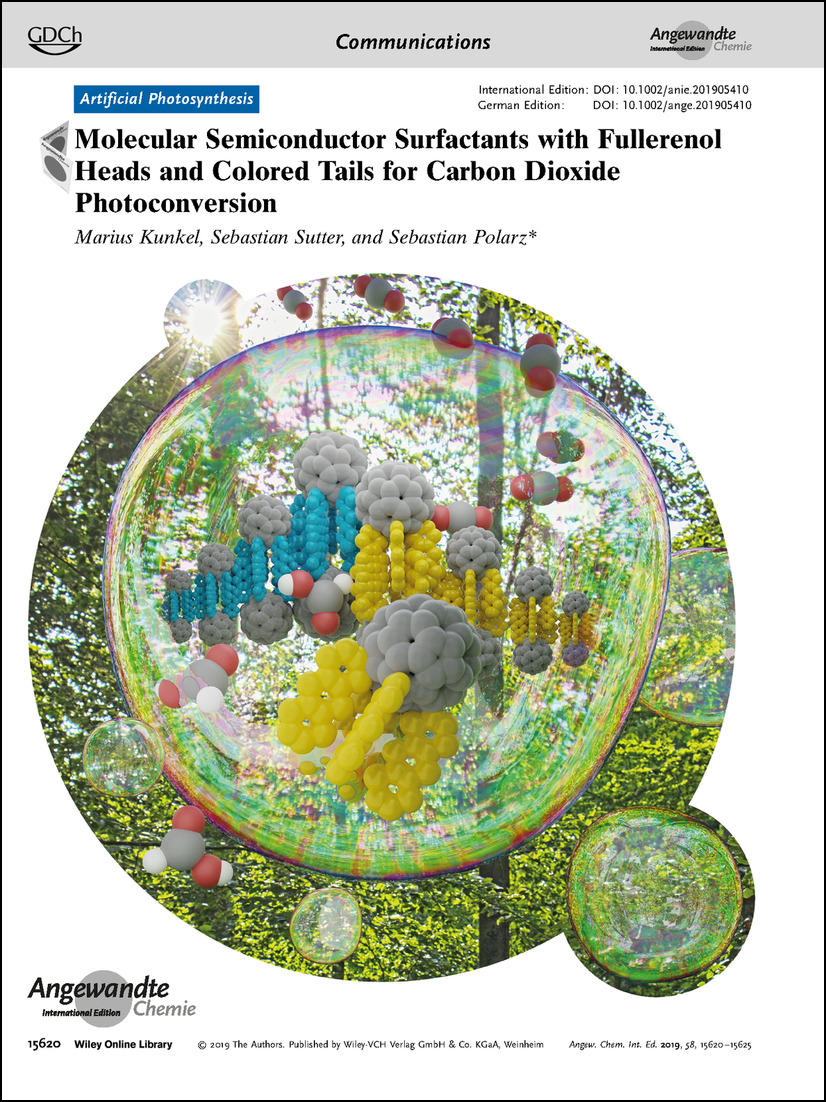
Artificial Photosynthesis In their Communication on page 15620 ff., S. Polarz et al. present surfactants consisting of dye molecules and a polyhydroxylated fullerene, which self-assemble into bilayer vesicles that mimic key functions of photosystems II and I.
Frontispiece: A Polymer Solution To Prevent Nanoclustering and Improve the Selectivity of Metal Nanoparticles for Electrocatalytic CO2 Reduction
- First Published: 21 October 2019
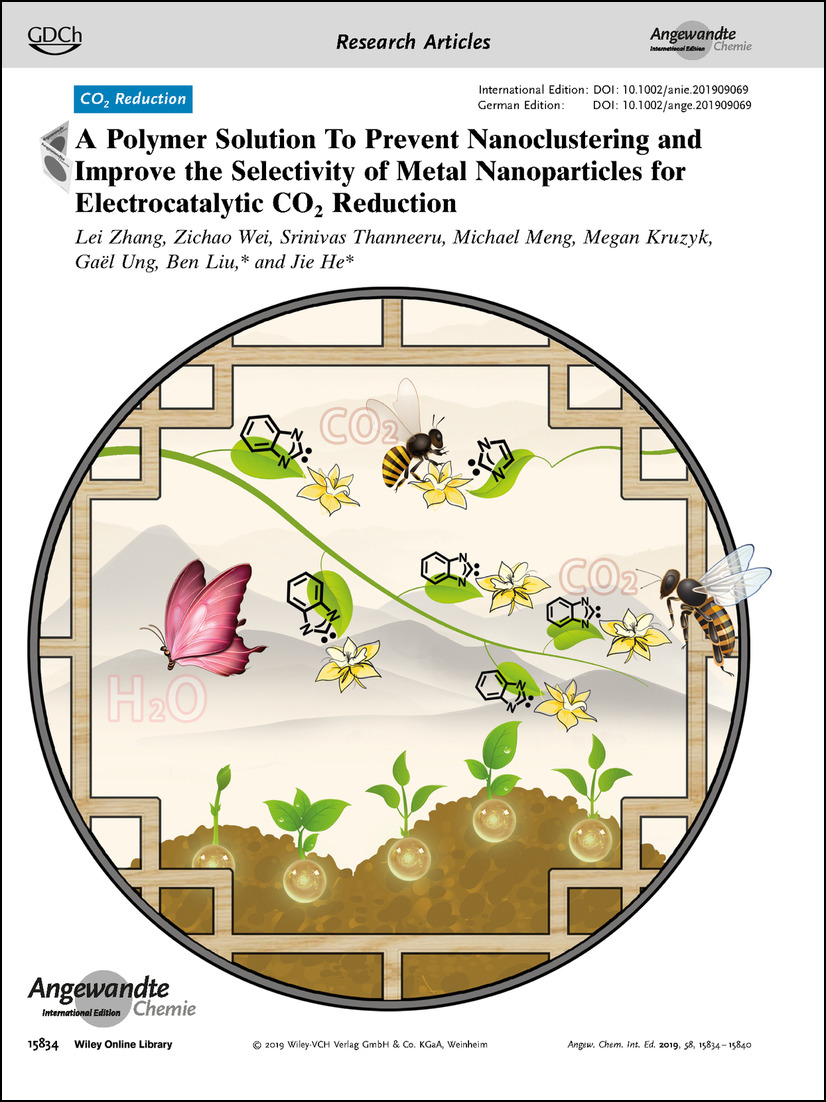
CO2 Reduction. Polymeric N-heterocyclic carbene (NHC) ligands are demonstrated to improve catalytic efficiency and lifetime of Au and Pd nanocatalysts for CO2 electroreduction by B. Liu, J. He et al. in their Research Article on page 15834 ff.
Graphical Abstract
Graphical Abstract: Angew. Chem. Int. Ed. 44/2019
- Pages: 15559-15576
- First Published: 21 October 2019
Corrigenda
Corrigendum: The cis-Diammineplatinum(II) Complex of Curcumin: A Dual Action DNA Crosslinking and Photochemotherapeutic Agent
- Page: 15576
- First Published: 21 October 2019
Author Profile
News
Alwin Mittasch Prize: P. van Leeuwen / BioTrans Prizes: D. B. Janssen and D. Rother / Tetrahedron Prize for Creativity: P. G. Schultz
- Page: 15579
- First Published: 08 October 2019
Highlights
Photocatalytic Water Splitting
Oxysulfide Semiconductors for Photocatalytic Overall Water Splitting with Visible Light
- Pages: 15580-15582
- First Published: 30 September 2019
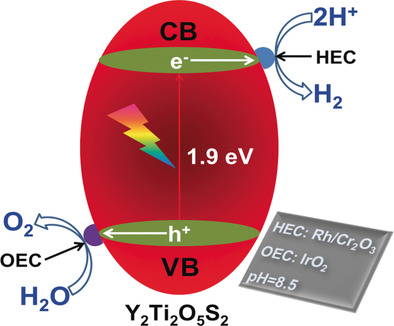
A Y2Ti2O5S2 oxysulfide photocatalyst that is activated and stabilized by Rh/Cr2O3 and IrO2 co-catalysts achieves efficient photocatalytic overall water splitting when irradiated with 600 nm visible light. The band gap of Y2Ti2O5S2 is a narrow 1.9 eV because Y 3d contributes to the valence band maximum. This Highlight discusses this recent innovation in sulfide-based photocatalytic materials. Key: conduction (CB) and valence (VB) bands, hydrogen (HEC) and oxygen (OEC) evolution co-catalysts.
Minireviews
Drug Delivery
Guiding Drugs to Target-Harboring Organelles: Stretching Drug-Delivery to a Higher Level of Resolution
- Pages: 15584-15594
- First Published: 25 June 2019
Reviews
Perovskite Solar Cells
All-Inorganic CsPbX3 Perovskite Solar Cells: Progress and Prospects
- Pages: 15596-15618
- First Published: 12 March 2019
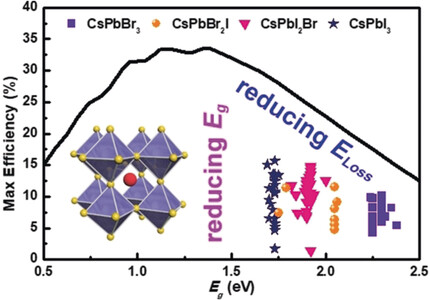
Thermally stable and able: All-inorganic CsPbX3 perovskites (X is halide) have attracted attention owing to their thermally stability for photovoltaic applications. This Review presents the various CsPbX3 materials and the challenges as well as perspectives for the future development of CsPbX3 solar cells.
Communications
Artificial Photosynthesis
Molecular Semiconductor Surfactants with Fullerenol Heads and Colored Tails for Carbon Dioxide Photoconversion
- Pages: 15620-15625
- First Published: 16 July 2019
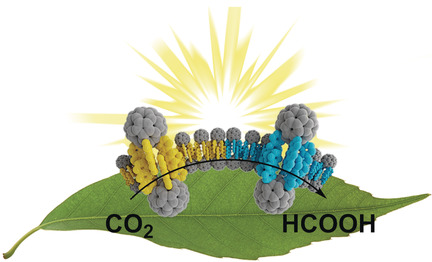
Photosynthesis with soap: Surfactants consisting of dye molecules and a polyhydroxylated fullerene self-assemble into bilayer vesicles that mimic key functions of photosystems II and I. They can absorb photons of two different visible wavelengths, exchange excited charge carriers, and thus enable the conversion of CO2 into formic acid.
Self-Assembly
Exploiting Coordination Isomerism for Controlled Self-Assembly
- Pages: 15626-15630
- First Published: 27 July 2019
Halogen–Lanthanum Exchange
Preparation of Polyfunctional Biaryl Derivatives by Cyclolanthanation of 2-Bromobiaryls and Heterocyclic Analogues Using nBu2LaCl⋅4 LiCl
- Pages: 15631-15635
- First Published: 28 August 2019
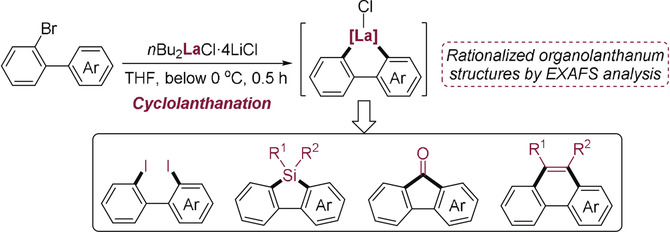
One stone, four birds: Various 2-bromobiaryl derivatives undergo a smooth cyclolanthanation upon reaction with nBu2LaCl⋅4 LiCl. The resulting cyclometalated lanthanum reagents are versatile intermediates for the facile preparation of valuable polyfunctional biaryl derivatives. X-ray absorption fine structure (XAFS) measurements rationalize the proposed structures of the involved organolanthanum species.
Water Interface
The Surface Activity of the Hydrated Proton Is Substantially Higher than That of the Hydroxide Ion
- Pages: 15636-15639
- First Published: 16 August 2019
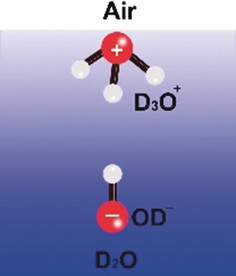
At the border: The relative surface propensity of hydrated proton and hydroxide at the D2O–air interface in the presence of excess D3O+/OD− was determined by probing the stretching vibration of interfacial water with sum-frequency generation spectroscopy. The hydrated proton is found to be orders of magnitude more surface active than the hydroxide ion.
C−H Activation
Arene-Free Ruthenium(II/IV)-Catalyzed Bifurcated Arylation for Oxidative C−H/C−H Functionalizations
- Pages: 15640-15645
- First Published: 02 September 2019
Protein Delivery
Peptide Brush Polymers for Efficient Delivery of a Gene Editing Protein to Stem Cells
- Pages: 15646-15649
- First Published: 12 August 2019
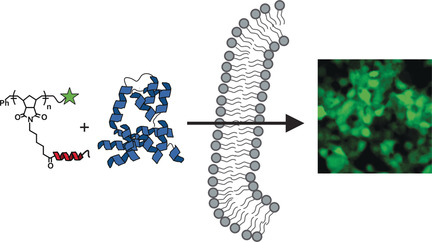
(B)rush delivery: The efficient delivery of an active DNA-modifying enzyme to human stem cells through high-density cell penetrating peptide brush polymers is reported. Brush polymer formulations utilizing cell penetrating peptides could promote delivery of Cre recombinase, whereas oligopeptides alone or oligopeptides displayed on nanoparticles did not.
Actinide Complexes | Hot Paper
[UF6]2−: A Molecular Hexafluorido Actinide(IV) Complex with Compensating Spin and Orbital Magnetic Moments
- Pages: 15650-15654
- First Published: 10 July 2019
![[UF6]2−: A Molecular Hexafluorido Actinide(IV) Complex with Compensating Spin and Orbital Magnetic Moments](/cms/asset/bc302235-28f9-4fbc-8937-3655fa1d7e21/anie201905056-toc-0001-m.jpg)
The electronic ground state of the weakly magnetic UIV was studied in great detail for the simple structurally characterized [UF6]2− anion, combining X-ray absorption spectroscopy, magnetometry, and quantum-chemical calculations. The decomposition and quantification of the relatively large spin and orbital magnetic moments provide key information for an improved understanding of the complex electronic structures of actinide ions.
Heterogeneous Catalysis
Supported Intermetallic PdZn Nanoparticles as Bifunctional Catalysts for the Direct Synthesis of Dimethyl Ether from CO-Rich Synthesis Gas
- Pages: 15655-15659
- First Published: 08 August 2019
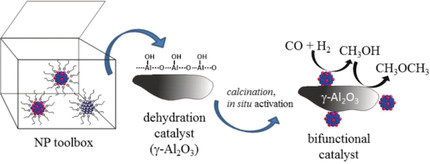
Zinc-stabilized palladium colloids with a size of about 2 nm are the key building units for bifunctional syngas-to-dimethyl ether catalysts with enhanced stability, longevity, and high dimethyl ether selectivity. The catalysts were characterized by combining high-pressure operando X-ray absorption spectroscopy and DFT calculations.
Bioinorganic Chemistry
Crosslinking Allosteric Sites on the Nucleosome
- Pages: 15660-15664
- First Published: 03 September 2019
Supramolecular Chemistry
Pillar[5]arene-Stabilized Silver Nanoclusters: Extraordinary Stability and Luminescence Enhancement Induced by Host–Guest Interactions
- Pages: 15665-15670
- First Published: 28 August 2019
![Pillar[5]arene-Stabilized Silver Nanoclusters: Extraordinary Stability and Luminescence Enhancement Induced by Host–Guest Interactions](/cms/asset/0c953ac9-7714-4cb9-8152-53f609376d5e/anie201906740-toc-0001-m.jpg)
Light pillars: Host–guest interactions of pillar[5]arene (P5)-capped silver nanoclusters (Ag29(LA-P5)12(TPP)2 with alkylamines and quaternary ammonium guest molecules resulted in the modulation of optical properties of the NCs, including an extraordinary circa 2000-fold photoluminescence enhancement.
Bimetallic Nanomaterials
Exposing the Delocalized Cu−S π Bonds on the Au24Cu6(SPhtBu)22 Nanocluster and Its Application in Ring-Opening Reactions
- Pages: 15671-15674
- First Published: 22 August 2019
Polyaromatic Hydrocarbons
Metal-Free Synthesis of Benzothiophenes by Twofold C−H Functionalization: Direct Access to Materials-Oriented Heteroaromatics
- Pages: 15675-15679
- First Published: 03 September 2019

Thio-fusion: Benzothiophenes are accessed from non-prefunctionalized arenes in a one-pot sequence involving an interrupted Pummerer reaction, [3,3]-sigmatropic rearrangement, and cyclization. The process does not require metals, proceeds by twofold C−H functionalization, and can be used to achieve the straightforward π-extension of polyaromatic hydrocarbons.
Organic Batteries
Tuning the Chemistry of Organonitrogen Compounds for Promoting All-Organic Anionic Rechargeable Batteries
- Pages: 15680-15684
- First Published: 19 August 2019

Charging ahead: The development of anion–ion batteries is possible by combining the benefits of p-type organic redox-active materials and molecular engineering to tune their working potentials. The pairing of an aromatic diamine as the positive electrode with a zwitterionic bipyridinium carboxylate compound as the negative electrode resulted in the assembly of an all-organic anionic battery.
Enantioseparation | Very Important Paper
Enantiospecific Desorption Triggered by Circularly Polarized Light
- Pages: 15685-15689
- First Published: 08 August 2019
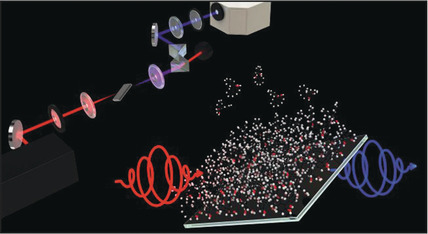
Light fantastic: By applying right (RCP) or left (LCP) circularly polarized light to racemic samples of 1,1′-bi-2-naphthol (BINOL) coated onto achiral glass substrates, preferential desorption of enantiomers can be achieved, thereby providing contamination-free enantioenrichment. There are no known mechanisms for this phenomenon, and a simplified phenomenological model suggests that the contribution of quantum mechanical processes should be revisited.
Alkyne Metathesis
Molybdenum Alkylidyne Complexes with Tripodal Silanolate Ligands: The Next Generation of Alkyne Metathesis Catalysts
- Pages: 15690-15696
- First Published: 26 August 2019

The canopy: Molybdenum alkylidyne complexes with triarylsilanolate ligands are privileged catalysts for alkyne metathesis, but tethering of the silyl groups seems to make things even better. Crystallographic data and a rare case study based on 95Mo NMR spectroscopy provide insights into why that is so.
Transition-Metal-Free Synthesis
Transition-Metal-Free Reductive Hydroxymethylation of Isoquinolines
- Pages: 15697-15701
- First Published: 05 September 2019
Bonding Properties
A Crystallographic Charge Density Study of the Partial Covalent Nature of Strong N⋅⋅⋅Br Halogen Bonds
- Pages: 15702-15706
- First Published: 23 August 2019
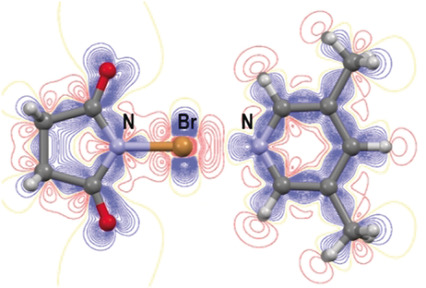
Crystallographic charge density analysis of a strong N−Br⋅⋅⋅N halogen bond in a N-bromosuccinimide and 3,5-dimethylpyridine co-crystal (NBS-lut) reveals a partially covalent character. Comparisons with pure crystalline NBS and the covalent bond in a bis(3-methylpyridine)bromonium cation suggest that there is a continuum of interactions between the intermolecular “non-bonding” halogen bond and a three centre–two electron covalent bond.
Supercapacitors
A Highly Elastic and Reversibly Stretchable All-Polymer Supercapacitor
- Pages: 15707-15711
- First Published: 23 August 2019

Elastic supercaps: An agar/hydrophobically associated polyacrylamide (HPAAm) double network (DN) hydrogel and pure polypyrrole (PPy) film based all-polymer supercapacitor was fabricated. It is highly elastic and reversibly stretchable. This supercapacitor can be stretched and recovered for 1000 times with no obvious performance degradation and strain residue, exhibiting excellent elasticity at the device level.
Zeolite Growth
Regulating Nonclassical Pathways of Silicalite-1 Crystallization through Controlled Evolution of Amorphous Precursors
- Pages: 15712-15716
- First Published: 31 August 2019
Porphyrinoids
Global Aromaticity and Antiaromaticity in Porphyrin Nanoring Anions
- Pages: 15717-15720
- First Published: 09 August 2019
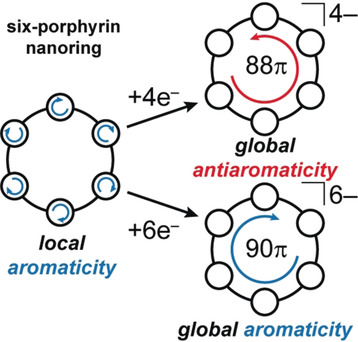
Negative isn't always bad: Reduction of a porphyrin nanoring by the addition of 4 or 6 electrons was found to result in global (anti)aromaticity (see picture), as revealed by 1H NMR spectroscopy and DFT calculations. Thus, the Hückel rules apply to huge macrocyclic anions, and the charge in these anions is fully delocalized.
Energy Conversion
Indeno[1,2-b]carbazole as Methoxy-Free Donor Group: Constructing Efficient and Stable Hole-Transporting Materials for Perovskite Solar Cells
- Pages: 15721-15725
- First Published: 26 August 2019
![Indeno[1,2-b]carbazole as Methoxy-Free Donor Group: Constructing Efficient and Stable Hole-Transporting Materials for Perovskite Solar Cells](/cms/asset/b42cf1cd-1251-42fa-8f15-152d1625436f/anie201909117-toc-0001-m.jpg)
Balancing act: The indeno[1,2-b]carbazole donor not only combines the characteristics of carbazole and fluorene, but also exhibits excellent thermal stability and high hole mobility as a result of the bulky planar structure. Hole-transporting materials based on this methoxy-free donor demonstrate a high efficiency and stability simultaneously, providing a promising strategy for developing efficient and stable perovskite-based solar cells.
Degradable Polymers
Modular Approach to Degradable Acetal Polymers Using Cascade Enyne Metathesis Polymerization
- Pages: 15726-15730
- First Published: 05 September 2019

Well-defined polyacetals are designed that readily degrade in aqueous environments through the use of enyne metathesis polymerization. This approach permits modular design of the monomer scaffolds, and post-polymerization functionalization with triazolinediones modulates the rate of hydrolytic degradation.
Natural Products
6-Methylenebicyclo[3.2.1]oct-1-en-3-one: A Twisted Olefin as Diels–Alder Dienophile for Expedited Syntheses of Four Kaurane Diterpenoids
- Pages: 15731-15735
- First Published: 20 August 2019
![6-Methylenebicyclo[3.2.1]oct-1-en-3-one: A Twisted Olefin as Diels–Alder Dienophile for Expedited Syntheses of Four Kaurane Diterpenoids](/cms/asset/f601c481-0d18-4d6a-bdd1-151300ca64d5/anie201909349-toc-0001-m.jpg)
With a twist: 6-Methylenebicyclo[3.2.1]oct-1-en-3-one, a twisted and highly reactive enone, was prepared for the first time by elimination of its bromide precursor. Its reactions as a dienophile with several dienes in Diels–Alder reactions proceeded smoothly to provide tricyclic and tetracyclic adducts, which allowed short syntheses (10–11 steps) of four kurane diterpenoids including 11β-hydroxy-16-kaurene, 11α-hydroxy-16-kaurene, liangshanin G, and gesneroidin B.
Linkage Isomerism
Magnesium Cyanide or Isocyanide?
- Pages: 15736-15741
- First Published: 28 August 2019
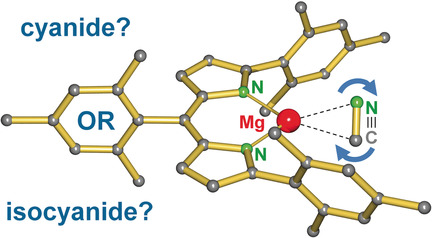
The two faces of CN: Cyanide ligands are generally C-bound in transition-metal chemistry, but for Mg, an isocyanide structure was established. Based on experiment and theory, at 298 K, a Mg−NC/Mg−CN ratio of 95:5 is found. In the solid state and in solution, isomerization is facile with a low energy barrier.
Covalent Organic Frameworks
Stable 2D Heteroporous Covalent Organic Frameworks for Efficient Ionic Conduction
- Pages: 15742-15746
- First Published: 21 August 2019

Planarization-enhanced stability: Dibenzo[g,p]chrysene (DBC), a “closed” version of tetraphenylethene (4PE), was integrated into a 2D heteroporous imine covalent organic framework (COF). The resulting DBC-COF exhibited much better crystallinity and stability than its counterpart 4PE-COF, and is a promising host material for ionic conduction.
Electroorganic Synthesis | Hot Paper
Electrochemical Arylation of Electron-Deficient Arenes through Reductive Activation
- Pages: 15747-15751
- First Published: 21 August 2019

An electrochemical method was developed for arylation of electron-deficient arenes through reductive activation. Various electron-deficient arenes and aryldiazonium tetrafluoroborates were examined for the transformation within an undivided cell, furnishing the desired products with up to 92 % yield. Reduction of quinoxaline is a key step in the transformation.
Molecular Switches | Hot Paper
A Chalcogen-Bonding Cascade Switch for Planarizable Push–Pull Probes
- Pages: 15752-15756
- First Published: 20 September 2019
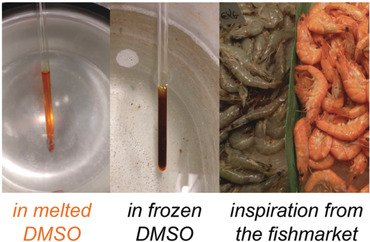
For the demonstration of physical forces in biology, a general concept in supramolecular chemistry that focuses on chalcogen bonds is introduced to access the desired stable, evolvable mechanochemistry tools. The source of inspiration of their rational design is illustrated in freeze–thaw cycles in DMSO.
Perovskites
Exploring Lead-Free Hybrid Double Perovskite Crystals of (BA)2CsAgBiBr7 with Large Mobility-Lifetime Product toward X-Ray Detection
- Pages: 15757-15761
- First Published: 27 August 2019
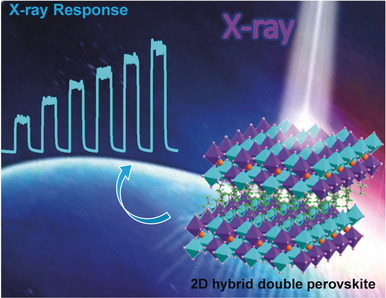
Finding X-rays: Single crystals of a lead-free hybrid double perovskite, (BA)2CsAgBiBr7 (BA+: n-Butylammonium), adopting a unique 2D multilayered quantum-confined motif, can serve as a potential X-ray detecting material. This promise stems from the large μτ product of 1.21×10−3 cm2 V−1, high bulk resistivity, low trap density, and efficient X-ray attenuation.
Dearomatization
Palladium-Catalyzed Dearomative syn-1,4-Oxyamination
- Pages: 15762-15766
- First Published: 03 September 2019
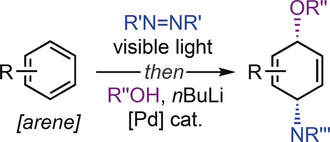
Escape from flatland: A dearomative strategy is reported based on combination of arenophile chemistry and Pd catalysis. Non-activated arenes were readily converted into the corresponding syn-1,4-oxyaminated products using oximes or benzyl alcohols as O-nucleophiles. This process delivers products with an exclusive diastereoselectivity, amenable to myriad of further elaborations.
Asymmetric Hydrogenation
Cobalt-Catalyzed Asymmetric Hydrogenation of C=N Bonds Enabled by Assisted Coordination and Nonbonding Interactions
- Pages: 15767-15771
- First Published: 29 August 2019

Interaction skills: Chiral nitrogen-containing compounds have been synthesized with excellent enantioselectivity (95–98 % ee) and high productivity (up to 2000 TON) by the Co-catalyzed asymmetric hydrogenation of C=N bonds. The reaction is facilitated by coordination of an NHBz group in the substrates to the cobalt atom and a nonbonding interaction with the ligand.
Electrocatalysis
Scaled-Up Synthesis of Amorphous NiFeMo Oxides and Their Rapid Surface Reconstruction for Superior Oxygen Evolution Catalysis
- Pages: 15772-15777
- First Published: 16 August 2019
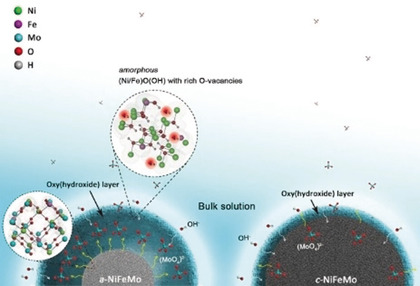
Amorphous NiFeMo oxide (up to 515 g one batch) with homogeneous elemental distribution was synthesized through a facile supersaturated co-precipitation method. The amorphous NiFeMo oxide undergoes rapid surface self-reconstruction during OER that forms a metal oxy(hydroxide) active layer with oxygen vacancies, enabling efficient OER catalysis.
Cyclizations
Carbene-Catalyzed Desymmetrization and Direct Construction of Arenes with All-Carbon Quaternary Chiral Center
- Pages: 15778-15782
- First Published: 28 August 2019
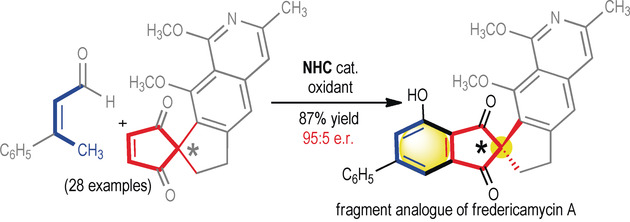
Indane formation: A one-step organic catalytic strategy for enantioselective access to indanes with an all-carbon quaternary center is disclosed. The reaction involves an N-heterocyclic carbene (NHC) catalyzed process for direct arene construction, indane formation, remote-carbon desymmetrization, and excellent chirality control. This approach enables the concise synthesis of arene-containing molecules, including those having complex structures and challenging chiral centers.
Systems Chemistry
Designed Negative Feedback from Transiently Formed Catalytic Nanostructures
- Pages: 15783-15787
- First Published: 02 September 2019
Supramolecular Polymers | Hot Paper
Hooking Together Sigmoidal Monomers into Supramolecular Polymers
- Pages: 15788-15792
- First Published: 11 September 2019
Polycyclic Hydrocarbons
A Short and Efficient Synthesis of the [3]Triangulene Ring System
- Pages: 15793-15796
- First Published: 05 September 2019
Lithium Metal Anodes
Highly Stable Lithium Metal Anode Interface via Molecular Layer Deposition Zircone Coatings for Long Life Next-Generation Battery Systems
- Pages: 15797-15802
- First Published: 10 August 2019

Protection at the nano-level: Molecular layer deposition is employed to fabricate a nanoscale “zircone” coating that is highly effective at stabilizing the Li metal anode interface. In-situ XAS is used for the first time to study the lithiation process of the artificial coating and the protected Li metal anode shows significantly enhanced cycling stability and lifetime in Li-O2 batteries.
Photochemistry
Asymmetric Synthesis of Heterocyclic γ-Amino-Acid and Diamine Derivatives by Three-Component Radical Cascade Reactions
- Pages: 15803-15807
- First Published: 06 September 2019
Heterocycles
Access to Multifunctionalized Benzofurans by Aryl Nickelation of Alkynes: Efficient Synthesis of the Anti-Arrhythmic Drug Amiodarone
- Pages: 15808-15812
- First Published: 22 August 2019
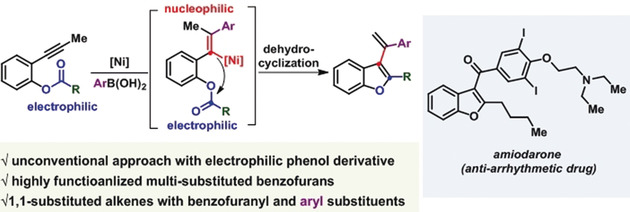
An unconventional nickel-catalyzed reaction has been developed for the synthesis of multifunctionalized benzofurans through the aryl nickelation of alkynes. A nucleophilic vinyl NiII species, from regioselective syn-aryl nickelation of an alkyne, undergoes an intramolecular cyclization with phenol ester to yield highly functionalized 1,1-disubstituted alkenes with 3-benzofuranyl and (hetero)aryl substituents.
Synthetic Methods | Hot Paper
Stereoselective Synthesis of Trisubstituted Vinylboronates from Ketone Enolates Triggered by 1,3-Metalate Rearrangement of Lithium Enolates
- Pages: 15813-15818
- First Published: 27 August 2019
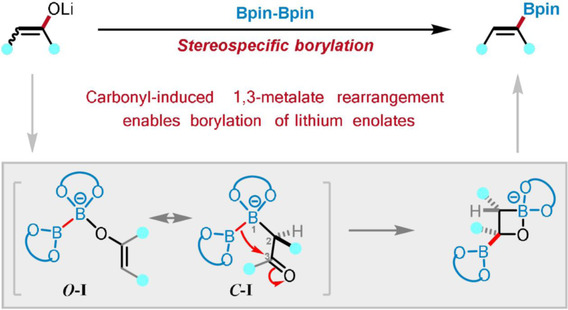
One to three: An unprecedented stereoselective synthesis of trisubstituted vinylboronates from the transition-metal-free borylation of lithium ketone enolates was developed. Carbonyl-induced 1,3-metalate rearrangement through a C-bound boron enolate leads to the stereospecific C−O borylation of lithium enolates. A variety of stereospecific tri- and tetrasubstituted vinylboronates were easily obtained.
Asymmetric Catalysis
Rhodium(I)/Zn(OTf)2-Catalyzed Asymmetric Ring Opening/Cyclopropanation of Oxabenzonorbornadienes with Phosphorus Ylides
- Pages: 15819-15823
- First Published: 06 September 2019

P-ylides: The use of Rh catalysis in the enantioselective ring-opening/cyclopropanation reactions of various P-ylides is demonstrated. This asymmetric reaction occurs through the cleavage of two bridgehead C−O bonds and the formation of two C−C bonds and constitutes the first highly enantioselective direct catalytic asymmetric cyclopropanation of stabilized P-ylide nucleophiles.
Organocatalysis
Atroposelective Phosphoric Acid Catalyzed Three-Component Cascade Reaction: Enantioselective Synthesis of Axially Chiral N-Arylindoles
- Pages: 15824-15828
- First Published: 28 August 2019

About the axis: The first organocatalytic atroposelective three-component cascade heteroannulation of 2,3-diketoesters, aromatic amines, and 1,3-cyclohexanediones has been developed. A wide range of axially chiral N-arylindoles were obtained in high yields and ee values by using a spirocyclic phosphoric acid catalyst. DCM=dichloromethane.
Radical Anions
Tricoordinate Nontrigonal Pnictogen-Centered Radical Anions: Isolation, Characterization, and Reactivity
- Pages: 15829-15833
- First Published: 03 September 2019
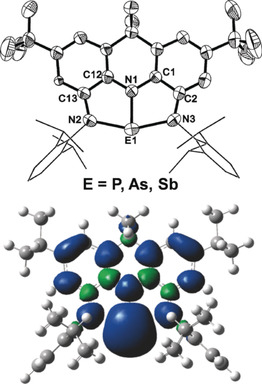
The selective one-electron reduction of nontrigonal R3E compounds (E=P, As, Sb) afforded the first stable tricoordinate pnictogen-centered radical anion salts; the pnictogen atoms retain a planar T-shaped structure. EPR spectroscopy and calculations reveal that the spin density mainly resides at the p orbital of the pnictogen atom, which is perpendicular to the N3E plane.
Research Articles
CO2 Reduction
A Polymer Solution To Prevent Nanoclustering and Improve the Selectivity of Metal Nanoparticles for Electrocatalytic CO2 Reduction
- Pages: 15834-15840
- First Published: 29 August 2019
Energy Conversion
The Three-Dimensional Dendrite-Free Zinc Anode on a Copper Mesh with a Zinc-Oriented Polyacrylamide Electrolyte Additive
- Pages: 15841-15847
- First Published: 22 August 2019

A dendrite-free zinc plating behavior was achieved by combining a Cu-Zn solid solution interface on a copper mesh skeleton and polyacrylamide electrolyte additive. The zinc ion has strong selective adsorption on the acyl group of polyacrylamide and can be transferred along the polymer chains, leading to the homogeneous zinc distribution.
Porous Films
Programmable Exposure of Pt Active Facets for Efficient Oxygen Reduction
- Pages: 15848-15854
- First Published: 02 September 2019
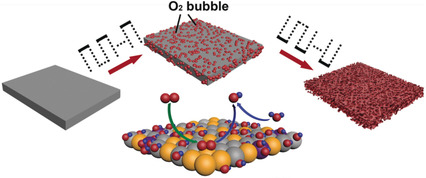
The unique dynamic oxygen-bubble template (DOBT) programmably controlled by a square-wave potential was utilized to tune catalyst morphology and expose Pt active facets in PtNi PFs. PtNi PFs with enriched Pt(111) facets can be obtained by affecting the surface-adsorbed OH* through adjusting the anodic voltage.
Layered Compounds
Computationally Driven Discovery of a Family of Layered LiNiB Polymorphs
- Pages: 15855-15862
- First Published: 01 August 2019
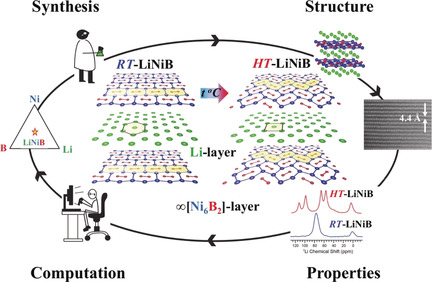
By design: Novel lithium nickel borides with unique layered structures were theoretically predicted and synthesized. Their structures are composed of [NiB] layers with different topologies alternating with layers of Li cations (see picture). These compounds are ultimate precursors for further exfoliation to generate 2D transition-metal borides, known as MBenes.
Mesoporous Materials
Molecular Design Strategy for Ordered Mesoporous Stoichiometric Metal Oxide
- Pages: 15863-15868
- First Published: 14 August 2019
Phase Transitions
Real-Time In-Situ Monitoring of a Tunable Pentapeptide Gel–Crystal Transition
- Pages: 15869-15875
- First Published: 02 September 2019
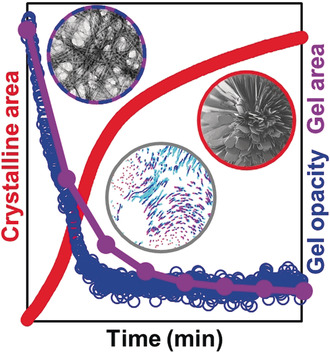
Unusual phase tester: An accessible pentapeptide system for studying gel–crystal phase transitions in supramolecular gels is introduced. The system allows to continuously measure the kinetics and visualize the dynamics of this common gel-destabilizing phase-transition process in situ using non-destructive microscopy-based methodology.
Bioorthogonal Reactions | Hot Paper
Photo-induced and Rapid Labeling of Tetrazine-Bearing Proteins via Cyclopropenone-Caged Bicyclononynes
- Pages: 15876-15882
- First Published: 02 September 2019

Light-induced protein labeling: Cyclopropenone-caged dibenzoannulated bicyclononynes (photo-DMBO) are photo-activatable dienophiles that engage in rapid inverse electron-demand Diels–Alder cycloadditions with tetrazines upon light-induced decarbonylation. Site-specific incorporation of methyl-tetrazine amino acids allows photo-induced protein labeling in living cells with spatio-temporal control using photo-DMBO fluorophore conjugates.
Mesoporous Materials
Polyethylene Aerogels with Combined Physical and Chemical Crosslinking: Improved Mechanical Resilience and Shape-Memory Properties
- Pages: 15883-15889
- First Published: 09 September 2019
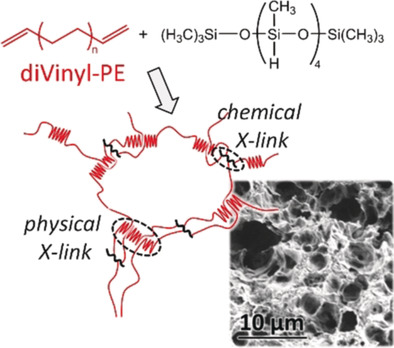
Taking shape: Polyethylene aerogels with low density and excellent mechanical resilience were obtained by combining and maximizing physical crosslinking, by crystallization, and chemical crosslinking, controlled by hydrosilylation reactions. These materials display remarkable shape-memory properties.
Nanostructures
Particle-in-a-Frame Nanostructures with Interior Nanogaps
- Pages: 15890-15894
- First Published: 03 September 2019
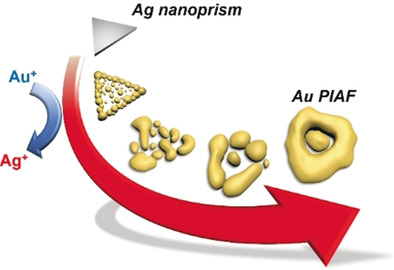
Particle in a frame: Gold particle-in-a-frame nanostructures with well-defined interior nanogaps were successfully generated through fine control over the galvanic replacement reaction of Ag nanoprisms with Au precursors. The prepared nanostructures exhibited enhanced plasmonic performance owing to their interior nanogaps, which strongly promote the plasmonic field.
Surface Chemistry
Electrochemical Oxidation of 5-Hydroxymethylfurfural on Nickel Nitride/Carbon Nanosheets: Reaction Pathway Determined by In Situ Sum Frequency Generation Vibrational Spectroscopy
- Pages: 15895-15903
- First Published: 27 August 2019
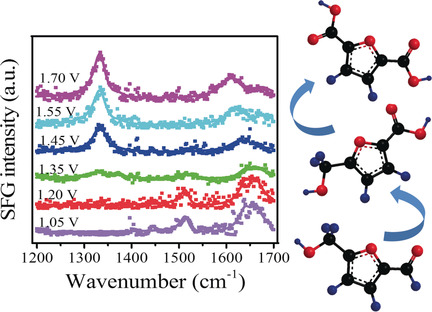
To sum up: A carbon-coupled nickel nitride nanosheet was employed as an efficient electrocatalyst for 5-hydroxymethylfurfural (HMF) oxidation. In situ sum frequency generation (SFG) spectroscopy was used to explore the HMF electrooxidation process, and confirmed that the oxidation pathway proceeds via 5-hydroxymethyl-2-furancarboxylic acid (HMFCA).
Phage Display
A Genetically Encoded, Phage-Displayed Cyclic-Peptide Library
- Pages: 15904-15909
- First Published: 09 August 2019

Using amber-codon suppression, Nϵ-acryloyl-lysine was genetically encoded in a phage-displayed peptide library for cyclization with a pre-installed cysteine. Selection from this phage-display library afforded cyclic peptides that bind TEV protease and histone deacetylase, HDAC8, much more strongly than their linear counterparts.
Batteries
A Dual Plating Battery with the Iodine/[ZnIx(OH2)4−x]2−x Cathode
- Pages: 15910-15915
- First Published: 02 September 2019
![A Dual Plating Battery with the Iodine/[ZnIx(OH2)4−x]2−x Cathode](/cms/asset/163a6a90-5770-4c97-84f7-1616d3586f41/anie201909324-toc-0001-m.jpg)
A highly reversible iodine plating cathode is presented that operates on the redox couples of I2/[ZnIx(OH2)4−x]2−x in a water-in-salt electrolyte. The iodine plating cathode with the theoretical capacity of 211 mAh g−1 plates on carbon fiber paper as the current collector, delivering a large areal capacity of 4 mAh cm−2.
Organocatalysis
Organocatalytic Enantioselective Functionalization of Unactivated Indole C(sp3)−H Bonds
- Pages: 15916-15921
- First Published: 19 August 2019

Not just one, but two: An organocatalytic asymmetric functionalization of unactivated benzylic C(sp3)−H bonds of alkyl indoles with trifluoropyruvates was developed with high enantioselectivity. Mechanistic studies and DFT calculations show an unusual mechanism, including the first installation of a trifluoropyruvate electrophile at C3 of indoles, towards the formation of the key enamine nucleophile, followed by the addition of the second trifluoropyruvate.
Covalent Organic Frameworks
High-Precision Size Recognition and Separation in Synthetic 1D Nanochannels
- Pages: 15922-15927
- First Published: 15 August 2019
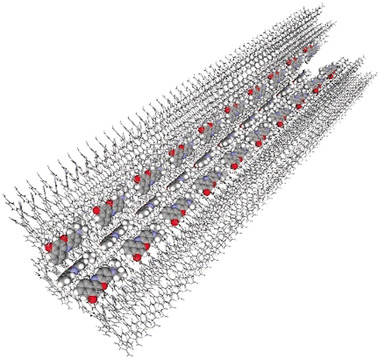
The right channel: Open 1D channels were able to recognize differences in molecular size when the pores were designed with a triangular shape and discrete size in covalent organic frameworks. This finding introduces the possibility of using 1D channels for selective transport and instant molecular separation with infinite selectivity (see picture).
Intermetallic Semiconductors
Interplay of Atomic Interactions in the Intermetallic Semiconductor Be5Pt
- Pages: 15928-15933
- First Published: 04 September 2019




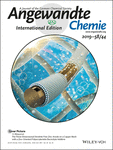
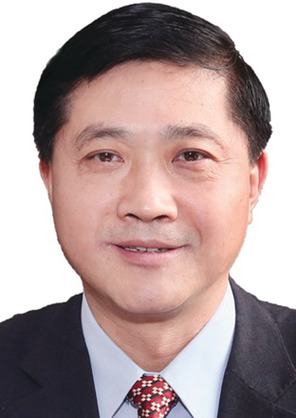


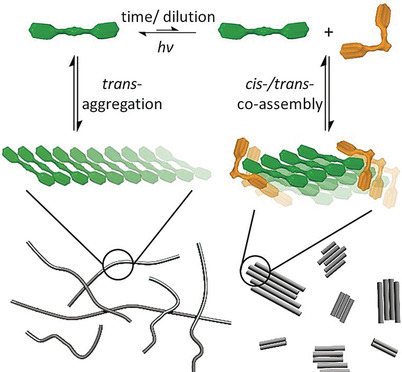

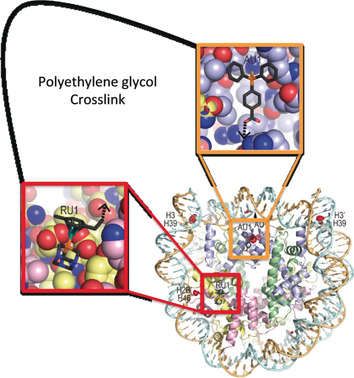
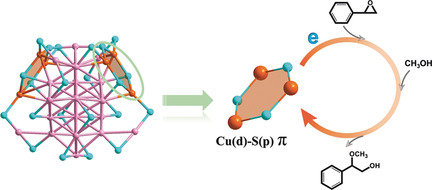
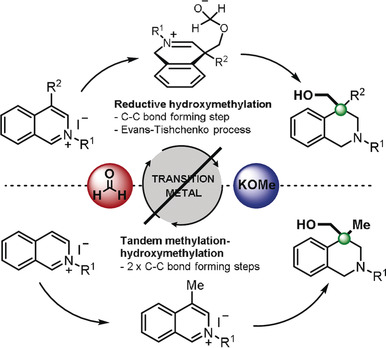
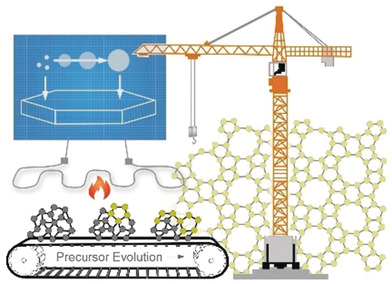
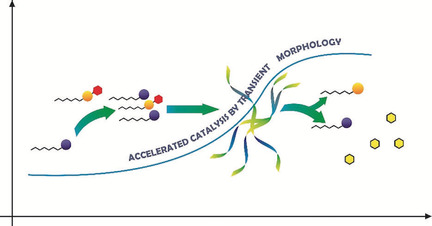
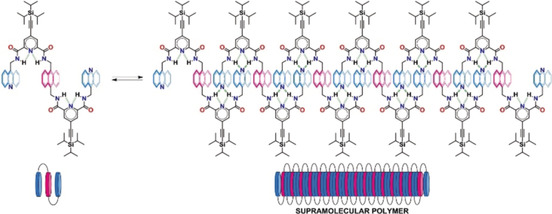
![A Short and Efficient Synthesis of the [3]Triangulene Ring System](/cms/asset/fa8bff8f-6473-4226-8d3f-2101cb3aaec3/anie201907226-toc-0001-m.jpg)

